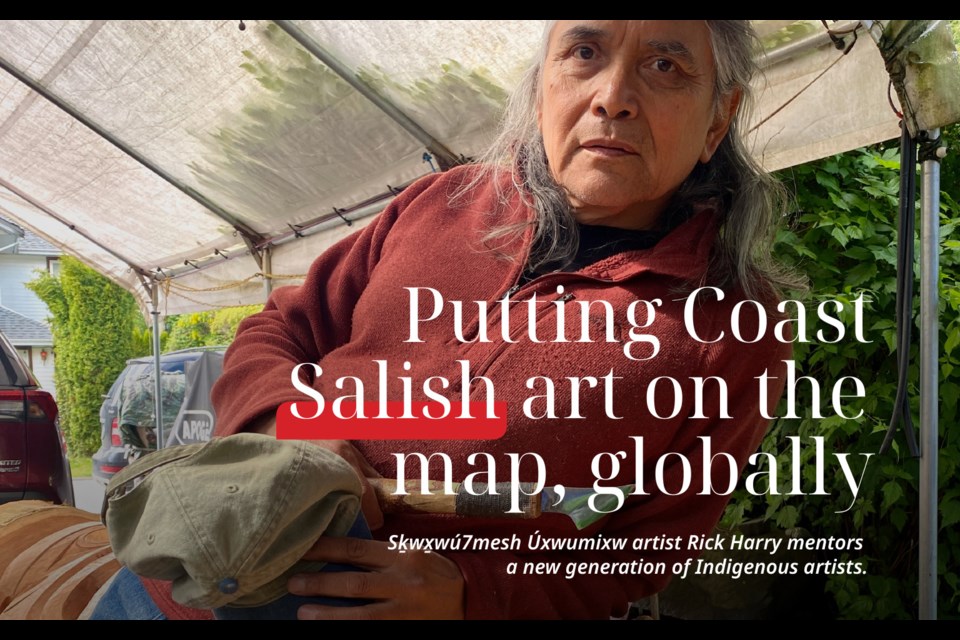He was the youngest kid in the whole class. Decades ago, when Rick Harry (Xwalacktun) was first getting interested in art, his mother took him down to Howe Sound Secondary in Squamish for an extracurricular painting class.
The precocious five-year-old had been doodling ever since becoming inspired by his older brother’s drawings, but hadn’t yet decided to make art his life’s work. His mother thought it was time for him to learn some new skills, so she enrolled him in a class that she figured would challenge him.
As Harry settled into the classroom, it dawned on him that he was completely surrounded by adults. This wasn’t a class intended for children, he realized—it was something serious. Right away, he understood his mother had high expectations of him, and as a dutiful son, he was determined to meet them.
Thinking back on that moment now, the 64-year-old Coast Salish artist credits that Howe Sound class with kicking off his multi-decade quest to become one of the most celebrated Canadian artists of his generation: Xwalacktun, an ancestral family name he received from his father.
“I feel real pride in that name. When I received it, my whole family received names. We stood on blankets and agreed that when we walk off these blankets we’ll walk in a different way. We were told, ‘Don’t dirty that name that has been carried through many generations before you.’ It came with a responsibility to carry myself in the best way I can, doing good,” Harry says.
That awareness of his place in a multi-generational lineage was crucial to informing Harry’s life’s work, with each story he uses in his sculptures or designs creating a link between him and the oral storytellers of the past. At the beginning of his career, he produced work in a more northern style, because that was all he’d been introduced to, but that was before encountering the work of Charles Elliott (Temosen) in 1990.
Harry had never seen Coast Salish art before, and Elliott’s work resonated with him deeply. He immediately began producing work exclusively in this style, and it’s these designs that would ultimately be mass produced when they were selected to help celebrate the Vancouver 2010 Olympics.
Suddenly, his work had achieved a global reach he had never dreamed of.
“Our merchandising for The Bay really stood out worldwide. My designs were on everything—towels, tea towels, T-shirts, jackets, decorative coins. I felt so proud to see Salish art on a world stage, and that really uplifted me and the Salish people,” Harry says, noting the event created an avalanche of interest in Coast Salish artwork and a significant uptick in the number of artists working within that genre.
It’s difficult to summarize a career as multi-faceted as Harry’s. One of the first big projects he worked on was at Expo 86, when he collaborated with another artist to create a giant metal thunderbird with a 40-foot wingspan. Locally he’s collaborated with nearly 10 school boards on various art projects, and he also makes time to meet with students and share his skills. If you visit Vancouver General Hospital, you’ll find one of Harry’s elaborately carved totem poles that’s illuminated from within, looming far overhead. He’s installed a metal sculpture that frames the sunset at Ambleside Beach, and created concrete support for a pedestrian overpass that’s carved with animals. The mayor of West Vancouver is set to give him an award for his contributions to art and culture, which he can add to a collection that includes a Diamond Jubilee Medal from the Queen.
“I work in wood, stone, jewelry, glass, and metal. I just enjoy doing art, whether I’m commissioned to work together with someone and design something or if I’m doing it completely for myself. What we need to make sure of is to give it life. It’s not just something beautiful you can hang on the wall. It needs to have a backbone,” says Harry.
“And that’s the story. The story can bring together the past, the present, and the future. It passes on messages that can help the generations after. My messages are to human unity, spirituality, and the environment. Because we need all of these things to survive.”
Harry is a member of the Sḵwx̱wú7mesh Úxwumixw, or Squamish Nation, and belongs to one of its most prominent families. His brother is chancellor at Quest University, his mother just received an honourary degree, and his sister is a well-known drum maker, blogger, and oral storyteller. He’s well aware that his familial environment played a significant role in his development as an artist, as did his community. He learned firsthand from a number of generous Indigenous artists growing up, which is why he’s so passionate about passing his knowledge along further.
These days Harry’s got a custom-designed studio at his North Shore home, but he travels all over the Lower Mainland to collaborate on art projects, work on installations, and teach classes. On May 11, he was granted an honourary doctorate from Emily Carr University of Art and Design.
When he took the stage, he knew that he wasn’t the only one responsible for putting him there—it takes a village to raise an artist.
“I said, ‘I’m so honoured to be standing in front of you. I’m also so pleased to have so many people behind me and around me that helped to get me where I am today, like my teachers from elementary school and high school and college, people in my community. There were so many people that helped me get here, including my mother,’” he says.
“I want to break the trail for others to follow, in some part, but then I want them to break their own trail. And that’s what they’re doing now. The ones I mentored are mentoring other young people who are doing really well in the art world now, so it’s creating a beautiful wave of artwork that’s coming to shore.”




